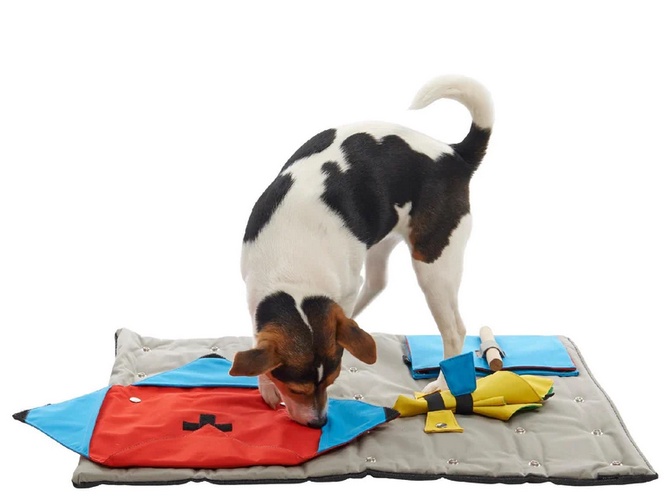Playtime is a crucial aspect of a dog's life, serving not only as a source of entertainment but also as a means of physical exercise and mental stimulation. Among the array of interactive toys available for our furry companions, dog treat dispensers stand out as an innovative and engaging option. In this exploration, we will delve into the world of treat dispensers, understanding their benefits, types, and how they contribute to the overall well-being of our canine friends.
Unlocking the Benefits of Treat Dispensers:
-
Mental Stimulation: Treat dispensers are designed to challenge a dog's cognitive abilities. The process of figuring out how to release the treats engages their minds, providing valuable mental stimulation. This mental exercise is especially beneficial for intelligent breeds or dogs prone to boredom.
-
Preventing Boredom and Destructive Behavior: Dogs left alone for extended periods may succumb to boredom, leading to destructive behaviors. Treat dispensers offer a constructive outlet for their energy, helping alleviate boredom and reducing the likelihood of chewing furniture or other undesirable activities.
-
Slow Feeding and Portion Control: Some treat dispensers are designed to dispense kibble gradually, promoting slower eating. This not only prevents digestive issues but also contributes to weight management by controlling portion sizes.
-
Interactive Bonding: Using a treat dispenser often involves interaction between the dog and its owner. Whether it's filling the dispenser, encouraging the dog to figure it out, or celebrating their success, this interactive element strengthens the bond between the pet and the owner.
Types of Dog Treat Dispensers:
-
Classic Treat Balls: These are spherical toys with a hollow center where treats can be placed. As the dog rolls or interacts with the ball, treats are dispensed gradually. They come in various sizes and materials, catering to different breeds and play styles.
-
Puzzle Feeders: Puzzle feeders involve more intricate designs, requiring the dog to manipulate certain parts to access treats. These can include sliding compartments, spinning elements, or flipping lids, adding an extra layer of challenge for the dog.
-
Electronic Treat Dispensers: Electronic dispensers are automated devices that release treats at set intervals or in response to specific cues. Some can be controlled remotely via a smartphone app, allowing owners to engage with their dogs even when they're not at home.
-
Freeze-and-Serve Toys: These dispensers involve filling a toy with a mixture of wet food or treats, freezing it, and then presenting it to the dog. This type of dispenser provides a refreshing and longer-lasting challenge for the dog.
Choosing the Right Treat Dispenser:
-
Size and Durability: Select a treat dispenser appropriate for your dog's size and strength. Ensure that the chosen dispenser is made from durable materials, especially if your dog is an enthusiastic chewer.
-
Ease of Cleaning: Opt for treat dispensers that are easy to clean to maintain hygiene. Look for options with removable parts or those that can be disassembled for convenient washing.
-
Adjustable Difficulty Levels: Some treat dispensers offer adjustable difficulty levels. Starting with an easier setting and gradually increasing the challenge helps acclimate your dog to the concept of using a treat dispenser.
-
Safe Materials: Prioritize treat dispensers made from non-toxic materials. Dogs may chew on the dispenser itself, and ensuring the safety of the materials used is essential for their well-being.
Incorporating Treat Dispensers into Playtime:
-
Introducing the Dispenser: When introducing a treat dispenser, allow your dog to explore it without treats initially. This helps them understand that the dispenser is a source of enjoyment.
-
Positive Reinforcement: Encourage your dog's interaction with the treat dispenser by providing positive reinforcement. Celebrate their successes and offer praise or additional treats when they figure out how to access the treats.
-
Variety of Treats: Experiment with different types of treats to keep your dog interested. Some dispensers work well with dry kibble, while others are suited for small, soft treats. Finding what your dog enjoys most adds to the overall appeal of the dispenser.
-
Supervised Play: Initially, supervise your dog during playtime with the treat dispenser to ensure their safety and to offer guidance if needed. Once they become familiar with it, they can enjoy independent play.
Conclusion:
Dog treat dispensers offer a delightful and interactive addition to a dog's playtime routine. Beyond being a source of entertainment, these dispensers provide mental stimulation, prevent boredom, and contribute to the overall well-being of our canine companions. With various types available to suit different preferences and play styles, incorporating a treat dispenser into your dog's routine enhances their daily activities and strengthens the bond between you and your four-legged friend. So, indulge your dog in the interactive delight of treat dispensers – an engaging way to make playtime more enjoyable and mentally enriching.


No comments yet